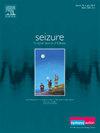Candidates for focal cortex stimulation in the outpatient population of an epilepsy reference center
IF 2.8
3区 医学
Q2 CLINICAL NEUROLOGY
引用次数: 0
Abstract
Background
Focal Cortex Stimulation (FCS) is a novel treatment for epilepsy. The patient population that may benefit from FCS has not been identified yet. This study uses data from a clinical trial screening at a tertiary epilepsy center's outpatient clinic to estimate the potential for FCS application
Objective
To determine the proportion of people with epilepsy (PWE) who could benefit from FCS considering focus localization and extent
Methods
All adult patients at the Freiburg epilepsy center outpatient clinic between October 1, 2019 and January 31, 2020, were screened for FCS eligibility. Suitable candidates needed to have 1) one predominant epileptic focus, 2) focus localization at the dorsolateral convexity, and 3) estimated focus size < 5 cm in diameter
Results
Epilepsy was confirmed in 562 of 604 patients. FCS was precluded in 205 patients due to specific epilepsy syndromes (e.g., genetic generalized epilepsies, mesiotemporal, unclassified). Patients with malignant tumors (25) or lesions outside the dorsolateral convexity (21) were excluded. In 16 of 41 multilesional patients and 18 of 35 nonlesional patients, a predominant focus was identified via EEG/semiology. In 40 of 127 patients with a neocortical single lesion, the lesion was deemed too extensive for FCS. Overall, 121 patients (21.5 % of all PWE, 26.5 % of focal epilepsy patients) were suitable for FCS, 56 of whom were drug-resistant
Conclusions
A significant proportion of PWE at a tertiary epilepsy center have a neocortical focus at the dorsolateral convexity, making them potential candidates for FCS. Given its efficacy and tolerability, FCS is a promising treatment for a major subgroup of patients with drug-resistant focal epilepsy
候选人局灶皮质刺激在门诊人口癫痫参考中心
局灶性皮质刺激(FCS)是一种治疗癫痫的新方法。可能受益于FCS的患者群体尚未确定。目的考虑病灶定位和范围,确定癫痫患者(PWE)受益于FCS的比例。方法对2019年10月1日至2020年1月31日在Freiburg癫痫中心门诊就诊的所有成年患者进行FCS资格筛查。合适的候选人需要有1)一个主要的癫痫病灶,2)病灶定位在背外侧凸起处,3)估计病灶大小<;结果604例患者中有562例确诊为癫痫。205例患者由于特定癫痫综合征(如遗传性全身性癫痫、中颞叶癫痫、未分类癫痫)而排除FCS。排除恶性肿瘤患者(25例)或背外侧凸外病变患者(21例)。在41例多发病变患者中的16例和35例非病变患者中的18例中,通过脑电图/符号学确定了主要病灶。在127例新皮质单一病变患者中,有40例认为病变过于广泛,不适合FCS。总体而言,121例患者(占所有PWE患者的21.5%,占局灶性癫痫患者的26.5%)适合FCS,其中56例耐药。结论在第三期癫痫中心的PWE患者中有相当大比例的新皮质灶位于背外侧凸起,使其成为FCS的潜在候选者。鉴于其疗效和耐受性,FCS对于耐药局灶性癫痫的主要亚组患者是一种很有希望的治疗方法
本文章由计算机程序翻译,如有差异,请以英文原文为准。
求助全文
约1分钟内获得全文
求助全文
来源期刊

Seizure-European Journal of Epilepsy
医学-临床神经学
CiteScore
5.60
自引率
6.70%
发文量
231
审稿时长
34 days
期刊介绍:
Seizure - European Journal of Epilepsy is an international journal owned by Epilepsy Action (the largest member led epilepsy organisation in the UK). It provides a forum for papers on all topics related to epilepsy and seizure disorders.
 求助内容:
求助内容: 应助结果提醒方式:
应助结果提醒方式:


